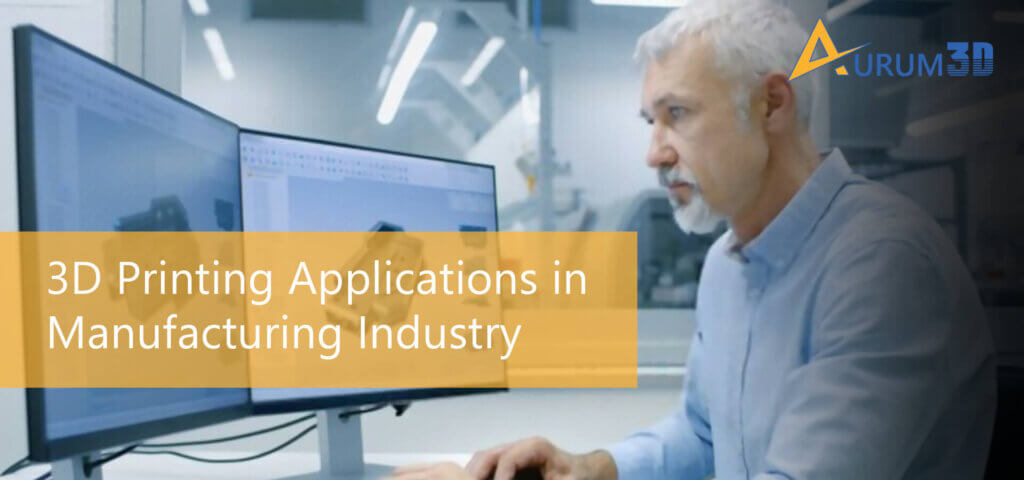The 3D printing technologies were initially developed with the aim to reduce the time and resources required for creating production prototypes. The manufacturing industry leveraged 3D printing technology to create and evaluate production prototypes in hours instead of weeks. But the manufacturing companies these days replace conventional manufacturing methods with 3D printing technologies to build products with out-of-box features or in small volumes.
The varying 3D printing applications in the manufacturing industry can be assessed from the number of projects launched by multinational manufacturing enterprises to 3D-print products on a mass scale. In addition to manufacturing a wide variety of products and prototypes, the manufactures use 3D printing technologies to experiment with new geometries and materials.
3D printing technologies further make it easier for manufacturers to allow consumers to customize a product according to their precise needs and expectations. Thus, the applications or use cases of 3D printing vary across manufacturers. But we can summarize 3D printing applications in the manufacturing industry based on a slew of innovative use cases.
9 Innovative 3D Printing Applications in Manufacturing Industry
3D Printing is a rapidly growing technology area. We are seeing new use cases of 3D printing applications on a daily basis. Here are some innovative 3D printing applications in manufacturing field.
Manufacturing Products in Smaller Volumes
The conventional production methods focus on producing a product in larger volumes. A manufacturer can earn profits only by producing a larger number of products. The overheads increase as the manufacturers curtail production volume. But 3D printing technologies enable manufacturers to produce products in a smaller amount without setting up expensive facilities. Many manufacturers these days leverage 3D printing to produce items on a case-by-case basis.
Offering Mass Customization Options
Most manufacturers leverage big data to understand the needs and expectations of customers. But the actionable insights gained by analyzing the big data do not enable the manufacturer to customize the product according to the precise needs of a consumer. But 3D printing enables manufacturers to offer mass customization options.
Many manufacturers these days allow every consumer to customize a product according to her own needs and preferences using the web-based customization software embedded into their websites. A consumer can customize a product according to her own choice before placing an order.
Allowing Consumers to Personalize
In addition to supporting mass customization, manufacturers also leverage cloud-based 3D printing technologies to enable consumers to build parts and components remotely. The cloud-based additive manufacturing technologies allow a consumer to 3D-print a component from a digital file. Some manufacturers allow consumers to obtain physical objects remotely without investing in a 3D printer. Many consumers these days leverage cloud-hosted 3D printing services to build specific products remotely and effortlessly.
Rapid Prototyping
According to a 3D printing trend survey sponsored by Jabil, “While prototyping remains the most accepted use of 3D printing in the majority of industries, production through 3D printing presents an incredible opportunity.” Most manufacturers leverage 3D printing technologies to speed up product designing and testing through rapid prototypes.
The product designers can use the right 3D printer to create multiple design iterations rapidly and repeatedly without investing extra resources. The manufacturers can get the prototypes evaluated by various stakeholders. They can further finetune the product design based on the feedback and suggestions before setting up production lines.
Implementing Bridge Manufacturing Workflow
As an important stage in product development, bridge manufacturing helps companies to bridge the gap between completing a prototype successfully and starting mass production. The manufacturers have to incur huge tooling expenses to set up production lines. But they cannot change or improve the prototype after setting up production lines.
3D printing technologies help manufacturing companies to implement bridge manufacturing workflow without setting production lines. Hence, manufacturers can evaluate and finetune the prototype repeatedly before starting mass production. They need to mass-produce only fully-functional 3D-printed products.
Experimenting with New Materials
Conventional manufacturing techniques require companies to manufacture products using specific materials. The manufacturers have to create multiple production lines to experiment with various materials. Hence, manufacturers use 3D printers to produce items using a variety of materials. The engineers can further evaluate and finetune the 3D-printed items to compare the viability of multiple materials. Many manufacturers already leverage 3D printing to boost product quality by changing primary raw materials.
Curtailing Production Cost
Most manufacturers have been replacing traditional production methods with 3D printing technologies to reduce production time and cost. Unlike traditional production methods, 3D printing does not require manufacturers to set up a production line by deploying multiple machines and men.
An engineer can use the right 3D printer to produce a ready-to-use product or component in a few hours. Hence, it becomes easier for manufacturing companies to bring down the overall cost of production by reducing labour cost. At the same time, the small manufacturing concerns eliminate the need to invest in expensive 3D printers by availing of professional 3D printing services.
Reducing the Cost of Quality Failure
The manufacturers can no longer attract and retain customers without launching products that stand out from the crowd. They carry out elaborate research and development (R&D) to design a product that will acquire market share by beating the competition.
The conventional manufacturing techniques make it difficult for manufacturers to redesign a product or create prototypes rapidly. But the manufacturers leverage 3D printing to evaluate the prototype rapidly and finetune the design repeatedly without investing extra resources and wasting materials.
Increasing Supply Chain Mobility
Most industrial and consumer products these days are produced in a distributed environment. The manufacturers outsource the production of parts or components to save both time and resources. Hence, large manufacturing companies can continue delivery and reduce time-to-market only by managing the supply chain efficiently. The 3D printing technologies enable manufacturers to shorten the supply chain and reduce the number of suppliers by producing components or parts on demand.
The manufacturing companies these days use 3D printers for a variety of purposes. Also, leading manufacturers use multiple 3D printing technologies to save time and resources. Hence, new use cases of 3D printing technologies in manufacturing will be created regularly in both short and long runs.

